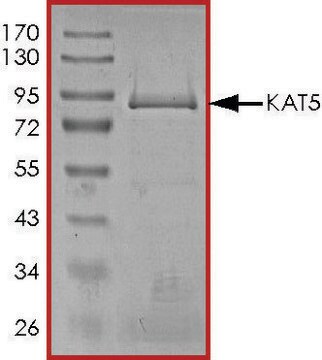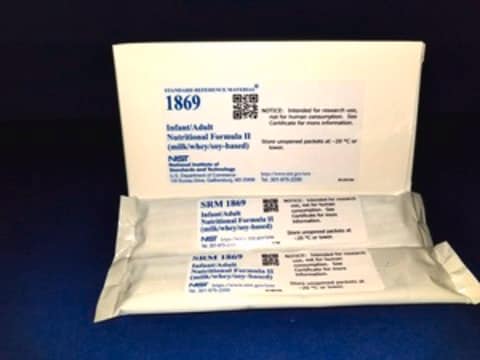SRP5220
KAT8 (2-467), GST tagged human
recombinant, expressed in baculovirus infected Sf9 cells, ≥70% (SDS-PAGE), buffered aqueous glycerol solution
Synonym(s):
FLJ14040, KAT8, MOF, MYST1, hMOF
Sign Into View Organizational & Contract Pricing
All Photos(1)
About This Item
Recommended Products
biological source
human
recombinant
expressed in baculovirus infected Sf9 cells
Assay
≥70% (SDS-PAGE)
form
buffered aqueous glycerol solution
mol wt
~83 kDa
NCBI accession no.
application(s)
cell analysis
shipped in
dry ice
storage temp.
−70°C
Gene Information
human ... KAT8(84148)
General description
Lysine acetyltransferase 8 (KAT8) or MYST histone acetyltransferase 1 (MYST1) is a signaling protein that belongs to the MYST family of histone acetyl transferases (HATs). MYST1 has a chromodomain that is involved in protein-protein interactions and targeting transcriptional regulators to the chromatin.
Biochem/physiol Actions
Lysine acetyltransferase 8 (KAT8) or MYST histone acetyltransferase 1 (MYST1) was originally isolated as a human immunodeficiency virus-1 (HIV-1) TAT-interactive protein, which plays important roles in regulating chromatin remodeling, transcription and other nuclear processes by acetylating histone and non-histone proteins. MYST1 is also involved in ataxia-telangiectasia mutated (ATM) function. It acetylates histone 4-lysine 16 (H4K16). The protein is a modulator of embryonic stem cells and an epigenetic regulator. It has been associated with gastric carcinoma.
Physical form
Supplied in 50mM Tris-HCl, pH 7.5, 150mM NaCl, 10mM glutathione, 0.1mM EDTA, 0.25mM DTT, 0.1mM PMSF, 25% glycerol.
Preparation Note
after opening, aliquot into smaller quantities and store at -70 °C. Avoid repeating handling and multiple freeze/thaw cycles
Storage Class Code
10 - Combustible liquids
WGK
WGK 1
Flash Point(F)
Not applicable
Flash Point(C)
Not applicable
Certificates of Analysis (COA)
Search for Certificates of Analysis (COA) by entering the products Lot/Batch Number. Lot and Batch Numbers can be found on a product’s label following the words ‘Lot’ or ‘Batch’.
Already Own This Product?
Find documentation for the products that you have recently purchased in the Document Library.
MOF phosphorylation by ATM regulates 53BP1-mediated double-strand break repair pathway choice.
Gupta A
Cell Reports, 8(1), 177-189 (2014)
Expression of hMOF, but not HDAC4, is responsible for the global histone H4K16 acetylation in gastric carcinoma.
Zhu L
International Journal of Oncology, 46(6), 2535-2545 (2015)
The Histone Acetyltransferase MOF Promotes Induces Generation of Pluripotent Stem Cells.
Mu X
Cellular Reprogramming, 17(4), 259-267 (2015)
K C Neal et al.
Biochimica et biophysica acta, 1490(1-2), 170-174 (2000-04-29)
We have identified a novel human gene product, hMOF, which exhibits significant similarity to the Drosophila dosage compensation regulator, MOF. A recombinant C-terminal portion of hMOF has histone acetyltransferase activity directed toward histones H3, H2A and H4, a specificity characteristic
Arun Gupta et al.
Molecular and cellular biology, 25(12), 5292-5305 (2005-06-01)
We have determined that hMOF, the human ortholog of the Drosophila MOF gene (males absent on the first), encoding a protein with histone acetyltransferase activity, interacts with the ATM (ataxia-telangiectasia-mutated) protein. Cellular exposure to ionizing radiation (IR) enhances hMOF-dependent acetylation
Our team of scientists has experience in all areas of research including Life Science, Material Science, Chemical Synthesis, Chromatography, Analytical and many others.
Contact Technical Service







